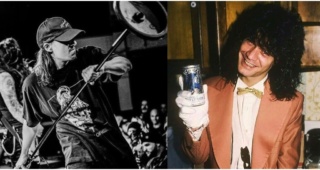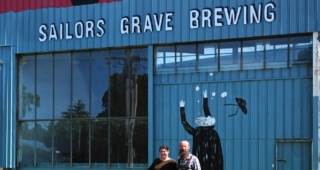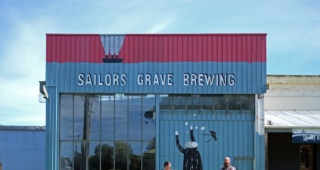It’s just two weeks since Off Day Beer Company launched in Singapore, and head brewer Daryl Yeap is back at the brewery brewing another batch because the first one is already sold out. The Off Day team thought it would last at least a month.
That first 3,000-liter batch, roughly 80-percent of which was kegged and the rest bottled, rolled out across many of the island’s leading craft beer bars to largely positive reviews. Now, with supply dried up and healthy demand for more, the production schedule has accelerated; not a bad thing.
Brewing near Singapore’s far western shores at General Brewing Co, Off Day is a collaborative effort between five local beer industry vets. Kevin Ngan owns GBC and has a stake in several beer bars, including Good Luck Beerhouse and Temple Cellars. Kasster Soh and partner Jasmin Wong are the co-founders of import company The Mad Tapper and partly behind Temple Cellars, Freehouse, and others. Daryl Yeap is head brewer at GBC and founder of Daryl’s Urban Ales, while Casey Choo manages That Singapore Beer Project.
As Yeap hits the brewhouse and Wong attends to other business, I catch up with the rest of the team for a chat about Off Day’s inception and modus operandi, and what exactly is going on in Jurong at the “mysterious” General Brewing Co.
Beer Travelist: How did the five cooks in the Off Day Beer kitchen get together on this?
Kasster Soh: All of us wanted a new creative challenge. Casey and Daryl have their own side brewing projects, Kevin wears a couple hats, and the same is true of Jasmin and myself. I think a new year presented a good time to do it. We’d been in discussions for this for almost nine months prior to launching, and since we all have expertise in different areas we thought we’d all come together to do something really cool, impactful, and maybe bigger than each individual part.
BT: Why these four beers for the launch?
Soh: It was quite a collaborative process, and we had a lot of options that were thrown on the table. I think we started with beers we generally wanted to drink ourselves; beers that we wouldn’t mind having a few times at one sitting. Off Day Beer is our flagship beer; we call it an “easy IPA.” We have a pale ale, which is probably the least hoppy beer of the bunch, and then Haze, which is probably the most difficult beer we had to make.
Casey Choo: Yeah, definitely… it’s a New England style, yet light drinking. Often I think “light drinking” comes across as watery, so making it still pillowy and flavorful was a challenge.
Soh: And then Double is our double IPA. We felt we had to make a real statement type beer; a beer for those days when you just have one. So we feel like we have two statement beers and two easy beers. We try to make beers reflective of our lifestyles and drinking patterns.
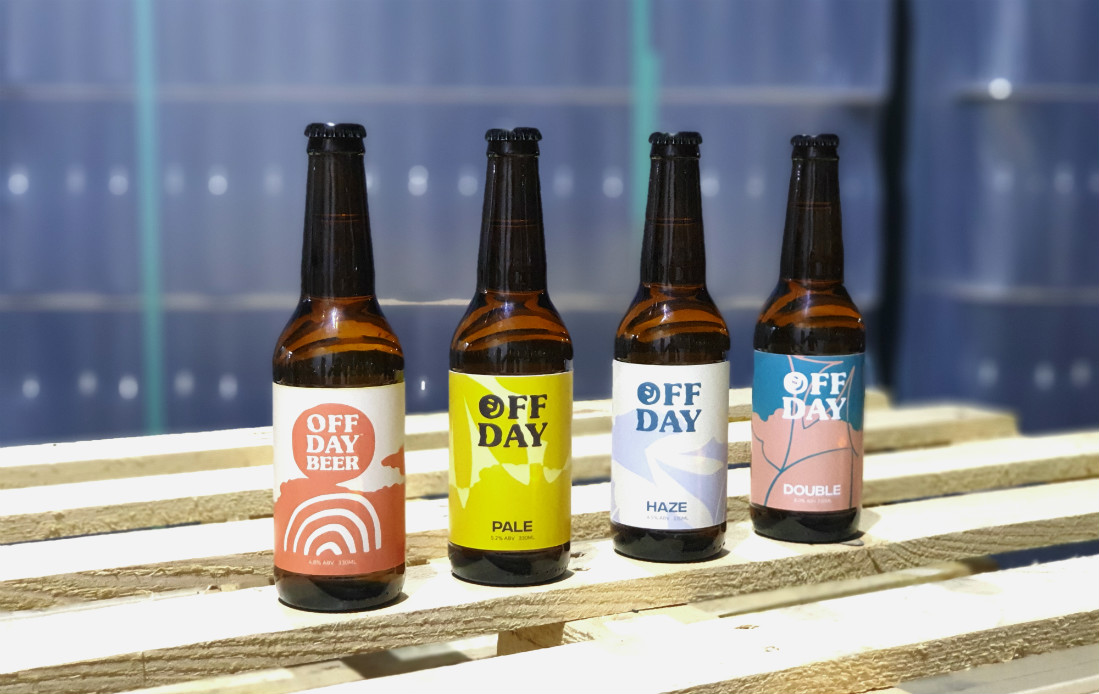
BT: It feels like you’re focused on presenting Off Day beers as “approachable.” Why that particular point of emphasis?
Soh: We look at the kind of beers we feel are suitable for Singapore in general. I mean, seven- to eight-percent IPAs, 10-percent imperial stouts—they’re all nice and trendy on Untappd, but they don’t really match the daily drinking patterns in Singapore, and we use that as a guiding principle. But it’s also just a reflection of what we drink, with all of us having been in the beer industry for awhile now.
Choo: But I still think they’re very big and flavorful. We’re starting to see here that big and flavorful beers in Singapore are great for capturing the more refined palate. With our idea of having fun, we designed the beers to be easy to try, and then when that happens perhaps drinkers will work down the range and end up at Double.
Kevin Ngan: Drinking is by and large still a social activity; not everybody is chasing flavors. It’s a small minority coming to a place like Temple Cellars, looking at the IBUs, the ABV, the brewery, so I think that’s something we’re thinking about with our range here.
BT: There are a lot of pale ales and session IPAs readily available in Singapore. What is distinctive about Off Day Beer Co’s versions?
Choo: I think Off Day Beer is something you can go to easily. You want to design a beer that has really good hop characteristics—flavorful, aromatic—but when you drink it, it’s light, tropical, not too bitter, and crisp. It’s the beer we can imagine having on a day off.
Soh: You’re right, there are a lot of session IPAs and pale ales. In a way you can’t really run away from that. You can’t be making a style that is completely new because a lot of people here may not get it. We didn’t set out to emulate session IPAs, pale ales, double IPAs as a starting range just because everyone else is doing it or just because it’s trendy.
I think we designed with lifestyles in mind, what we want to drink, and what kind of activities we see beers being associated with in Singapore, and used that as the backbone. Like Kevin said, I think beer is a very social beverage, and as much attention as we’re putting on our beers, we’re also putting a lot on branding, and building the right associations to it, so the beers fit into context with those things.
BT: How does one build awareness, or buzz, about a new brand or brewery?
Ngan: It’s not a primary objective, for our brand, to build buzz for the sake of it. We all have our own other things, so this is really a passion project for us. We thought it was the right time to give ourselves a challenge, and decided that if we were going to do something, it had to be fun and meaningful for us. We hope that will translate into good vibes for others.
We look at it as a very modern take on what a craft brewery should be. When it comes to the design elements, social media engagement, and things like our Spotify playlist, those are things we feel will be fun for people following the brand, but also fun for us.

Soh: We’re not looking to create hype. First and foremost we want to have fun and put a quality product into the market. We obviously use marketing channels and social media and all that, but something that’s not talked about enough is working closely with a bunch of bars that are ready to back us up. We launched with 13 or so craft beer bars, so it was an island-wide effort. We want them be excited about the brand and feel like they’re growing alongside us.
BT: It’s a somewhat small beer market in Singapore. How do you stand out?
Soh: The beer is of course important, but we’re putting a lot of focus on associations with the brand. “Off Day Sessions” is something we’ll do that we hope will integrate weekend lifestyle activities with good associations with beer. In a few weeks we’ll do a pottery session that will have our beers there, and that will be the first of many monthly activities. We’re also looking at the cycling community, photography enthusiasts… these sessions are something we see as a core activity for us.
Off Day Beer merchandise features very, very strongly for us since day one, as well. Again, we obviously want to make good beer, but also want to be a brand that has the right apparel that people don’t mind wearing regularly.
Choo: The Off Day Sessions also stem from our collective DNA of wanting to keep things easy-breezy for people. We want these events to be a reminder to people to be a little bit easier on themselves. They’re a good excuse to go out, and they’re something to look forward to, something people can get behind.
BT: Who is Off Day trying to reach?
Soh: We believe that good beer is for everyone. As cliché as that may sound, everyone should have access to great beer, and we want to do that via not only great liquid, but also branding that’s very relatable. We don’t people to feel too intimidated by it.
That being said, yes, we do want to target a broad audience, but at the same time we think our beers are exciting for those craft drinkers who want something new and challenging.
BT: Kasster, I don’t think it’s a leap of faith to suggest Stone & Wood, which is one of the breweries you import at The Mad Tapper, is somewhat of an inspiration here with some of Off Day’s sustainability goals.
Soh: It’s not just Stone & Wood. There are a lot of breweries out there that put a high emphasis on sustainability, and there’s good reason for that. As you would know, brewing is very resource intensive, so quite early on we identified this as something we want to get behind. We believe that when you’re taking so many resources you have to find a way to give it back, or add value to the waste products.
One thing we’re trying to do is work with Ah Hua Kelong to make fish feed from our spent grains. For us it’s the first of many initiatives we want to do, and as we go about our business we’ll hopefully meet others that share our beliefs.
Ngan: I will say that for a lot of these activities we really try to build a business case for them, as well, because there’s no point talking about sustainability and all that when in the end the business case is weak and it doesn’t sustain itself.
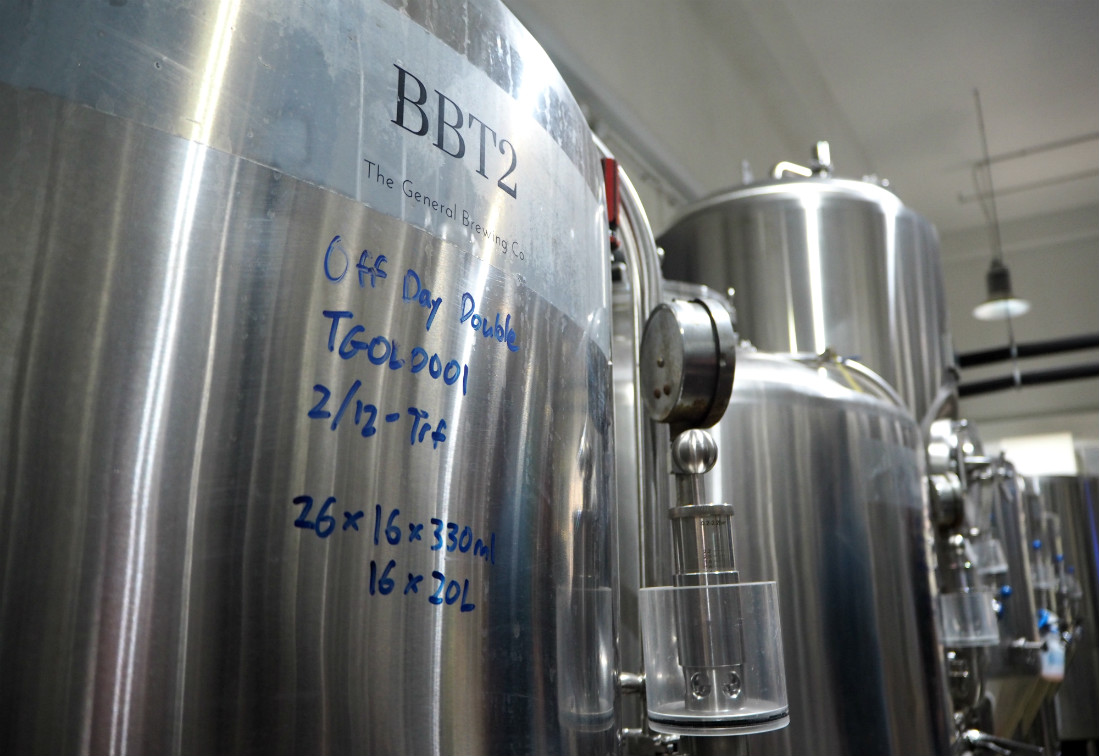
It’s going to be a long-term thing, but I think it’s a great start and something we want to build into the brand’s DNA. For us, individually and as business owners, we want to think harder about the things we do and how we can do them better. Those are things that will guide us in further developing the brand.
We’re a small brewery; we’re not a big facility with all this advanced technology to help us do some of this stuff. I think it’s most important for us to have the right motivation for doing it.
BT: Kevin, is that something you want to extend beyond Off Day Beer production to General Brewing Co at large?
Ngan: It makes sense for the facility itself to be driven in that direction. People like Brewlander brew there, as well, so all these initiatives will be made available for all brands brewing at the facility. We’re pragmatic about it; again, we’re small. What we can do is limited, but I think the ethos is important, and that will attract the right kind of partners that want to work with us, as well. That’s the critical part.
BT: What kind of volume are you doing at The General Brewing Co?
Ngan: Well, the theoretical number would be about 14,000 liters a month. It depends how hard Daryl wants to work—work his ass off and we can probably get there (laughs), but with work-life balance anywhere from 10 to 12,000 is sensible. It’s a good step up from 3,000/month, which is what we used to do.
BT: I’m not sure most people are aware of The General Brewing Co—who is behind it, what it’s all about. Is it a brand with its own brewery, a brand incubator, a contract brewery?
Ngan: We’re definitely not a contract brewing space, that’s for sure. You know the history of the facility—it used to be Innocence Brewing, and then the owner left the country and we took it over almost on a whim to see what we could do with the space. My motivation back then was… we were lacking in local breweries, lacking in capacity for homebrewers who wanted to try out brewing commercially. General Brewing Co was born out of that purpose—to be an incubation space for local brewers that deserved an opportunity.
It’s a small facility. When we took over the space there was a five-hectoliter brewhouse, four fermenters, two bright tanks—I mean, 3,000 liters is nothing. You can’t even break even for a facility with that, so we got our expansion going.
We want to work with people in the brewing industry we feel can bring something special to what Singapore is doing. Off Day is one of those things for which I’ve been waiting a long time. Jasmin, Kasster, and myself work together on Temple Cellars for the same reason—trying to do something different for the industry.
It’s not by design that General Brewing Co isn’t quite out there marketing wise. There are just too many things on my plate. I wish I could do a better job with the design, the logo, the social media, but it’s just not high on my agenda. We look at the General Brewing Co beers that you see at some outlets around Singapore as opportunities for us to try out recipes. We don’t have a game plan to have our own core range.
My job is to help more Singapore brands get out there and prosper in Singapore’s craft beer movement. We don’t just take anyone. We need to know the person’s background, and that he or she shares our same values. We care a lot about the people that are involved in the project, and we want to make sure the people that step in to brew with us have the right motivation and want to do the right stuff for the Singapore craft beer scene.

I’ve seen some markets where people have plenty of capacity for anyone to come right in and brew. Taiwan is one example—there are so many random brands in the market, and honestly, 90-percent of them are not great beers and leave a bad name on the industry. I personally don’t want that for Singapore, so that’s why we spend a little more time finding the right people.
BT: I spoke with somebody in the industry a few months ago who said Singapore is “pretty much the worst place to brew beer.”
Ngan: I will say there are a lot of things working against us. It’s not the easiest regulatory wise, and Singapore isn’t exactly the type of place to advocate vices. A lot of the official processes are cumbersome, and I think the financial threshold is quite high to start a brewery. I mean, we’re one of the most expensive cities in the world.
At the same time, we have fairly good access to hop pellets and other ingredients for us to brew good quality beer. I think if you look at Malaysia, Indonesia, the Philippines, and other parts of Southeast Asia, it’s a lot harder for them to find this type of quality of ingredients.
BT: What is special or unique about Singapore’s beer scene?
Ngan: It can be seen as a negative thing, but for me it’s rather nice that things have grown organically and slow enough for it to be sensible. You see a lot of markets where everybody is jumping on the bandwagon, and the brewery suffers, and it becomes cutthroat. In Singapore, the fact that it has slowly rose up, without any big money being thrown at it… I think we’ve built a good business case here for craft beer growth.
It’s a small industry—everybody knows everybody—and we work together to try to do what’s best for what we have here in Singapore, knowing there’s always a limitation in the market. We clearly don’t drink enough here; nobody drinks enough beer (laughs). But I quite like that it’s a sensible industry with no crazy people coming in with crazy money and wrecking this for us.
BT: Toss-up question for each of you: If you could go anywhere in the world strictly for beer, where would you go and why?
Soh: Mine is Germany. I think they make the best beers in the world, the lagers and pilsners, using just four ingredients to make fresh, crisp, easy-drinking beers.
Choo: My first thought was America or New Zealand, but I think I’d go back to New Zealand; I was based there for six months, five minutes away from Garage Project. People there are friendly and happy to share, and the beers are definitely good. Drinking from the cellar doors there is a great experience.
Ngan: My wife would tell you I’m not one who likes traveling much; I enjoy the company more than anything else. From the perspective of having an understanding of a market, though, the States would be a great place. No matter how cutthroat it is, what they’ve done is amazing. Pragmatically, that would be a great market to observe and bring some of the positive stuff into the Singapore market.
###
Off Day Beer Company is tapped at craft beer bars across Singapore; check UnTappd for updates on the latest venues. Bottles are available online at Temple Cellars.
Brewery, merch, and bottle photos courtesy of Off Day Beer Co; lead photo copyright Beer Travelist. This story was edited while listening to Fugazi’s First Demo.



